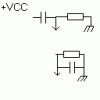mstechca
New Member
In my receiver, I am at the moment, using a CMOS 4024 IC.
After research, I think that switching to a counter in a 74HCT IC is better, provided that I change my voltage.
I don't know the best class to use.
What I have learned from experience is that the 74LS series tend to burn out easier.
so can someone list me in order of maximum voltage, followed by maximum speed which IC family I should use?
I'm willing to buy another counter IC. I would like the receiver to run on 9V as well, so any IC that works with 9V will be great.
After research, I think that switching to a counter in a 74HCT IC is better, provided that I change my voltage.
I don't know the best class to use.
What I have learned from experience is that the 74LS series tend to burn out easier.
so can someone list me in order of maximum voltage, followed by maximum speed which IC family I should use?
I'm willing to buy another counter IC. I would like the receiver to run on 9V as well, so any IC that works with 9V will be great.



